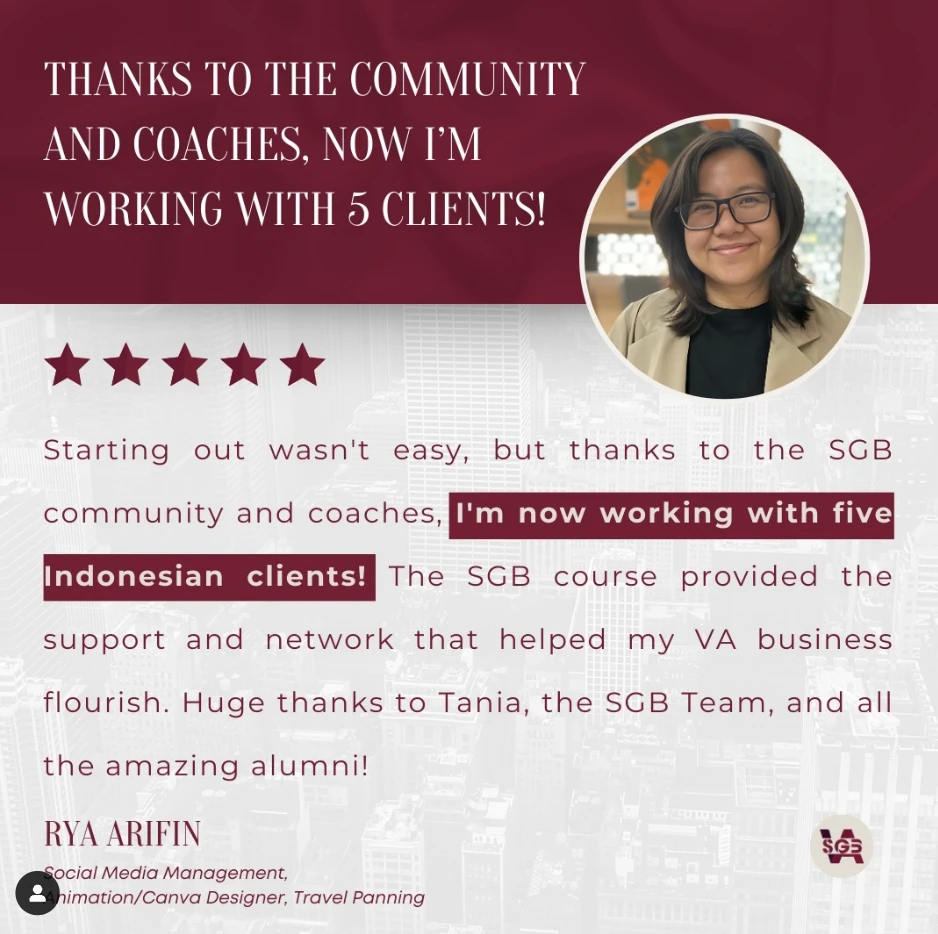Cara Dapat 4 Klien Luar Negeri Cuma Modal Notion ala Eka – DAFTAR TALKSHOW GRATIS
Have a Question? Contact Us.
Cara Dapat 4 Klien Luar Negeri Cuma Modal Notion ala Eka – DAFTAR TALKSHOW GRATIS


Oni Lestari
Virtual assistant, copywriter, SEO-expert
Ever dream of working from anywhere in the world, setting your own hours, helping businesses grow, and earning a good income? Becoming a Virtual Assistant (VA) might be the perfect fit for you! The virtual assistant industry is booming, offering opportunities to utilize your skills for various clients—all from the comfort of your home.
But where do you start? Don’t worry! This ultimate Virtual Assistant 101 guide is here to break it down for you. SGBVA will cover everything you need to know, from identifying your virtual assistant skills to finding your first client and launching a successful remote career. So, grab a cup of coffee, get comfy, and let’s explore the exciting world of virtual assisting!
Table of Contents:
First, let’s establish a clear understanding of who a virtual assistant is. A virtual assistant is a remote worker who provides administrative, technical, or creative assistance to clients. They work online, offering their services on a part-time or full-time basis. They dedicate their time and expertise to supporting business needs.
Now, we’re ready to talk about how to build a strong foundation to prepare yourself before you start to approach a potential client as a virtual assistant. Sometimes when we start something new, adrenaline pushes us forward and makes us want to kick off the projects right away. But sometimes an initial idea without a clear vision will leave you with half-finished tasks. That’s why having a solid plan is crucial. So in this article, we’re gonna take a deep dive into the key steps to set you up for success as a virtual assistant.
First things first, let’s nail down your niche and the services you’ll offer. If you’re new to this, you might be wondering what niche is, let’s talk about it in the most basic terms. Niching is choosing an area to specialize in. This helps you decide who you’ll work for and what services you’ll offer. Most of the time when you hear about a niche in the VA context, you’ll hear people say, “I work for coaches to finish their to-do list”, or “My niche is YouTubers or wellness business owners.” There are many different niches because the opportunities to work with virtual assistants are endless. Business owners, self-employed individuals, and even employees all have the possibility of needing a virtual assistant.
How do you figure out your niche? This question can be one of the most challenging aspects for beginners. We’re going to explain what a niche is and how to decide on your niche. But before we delve deeper, let’s make it clear: you don’t have to lock yourself into a niche. The best part of being a virtual assistant, or a business owner of any kind, is the flexibility to pivot your business as needed. If you choose a specific niche now, you can change it anytime. To figure it out, you can start by answering these two questions. One, “what skills do I already have that I can use to serve clients?” and two, “what type of tasks do I want to be doing as a virtual assistant?”
Let’s start with the first question: What skills do you have? This can be anything, so get creative! You’ll need to brainstorm a list of all the skills you have from any previous jobs, school, or even personal hobbies. It can be something super simple, like being great at writing emails, organizing your family schedule, or having coding skills. Anything you think could be transferred to a business setting or offered as a service goes on the list. Just get it all down in front of you, whether on a piece of paper or in your notes app. If you dive deep into what you can do, you’ll be surprised at the thousands of things that could end up on your list!
The second question to ask yourself is: What type of tasks do you WANT to be doing as a VA? What are you DREAMING of doing? If you’ve considered becoming a VA, you probably already have some ideas in mind. Now’s the time to write that list down! Don’t limit yourself to what you think you can do right now. Honestly, new and exciting tasks will often pop up when you’re working as a VA that you hadn’t even considered before. You’ll be surprised by your ability to figure things out as you go.
Do you dream of helping someone launch their podcast? Or maybe you’d love to work with writers to get their books out to the world? The opportunities are endless when you’re a VA! There are no rules that say you can’t work with specific clients or in specific areas just because you’re a virtual assistant. Dream big – you can make anything happen, even if it takes some time. Don’t hold yourself back!
When you have this list, you can review it repeatedly to make sure everything aligns with what you want to do, not what you feel obligated to do. This is your chance to break free from tasks that no longer bring you joy. So, choose activities that spark excitement and ignite a sense of fulfillment.
Now you have two sets of answers. See which ones might work well together. For example, if you have excellent email communication skills and want to work with small businesses, then your niche might be “small business owners” and your service offering could be “customer service.” If you love to write and want to work with podcasters, then your niche is “coaches” and your service could be “coach assistant.” Being clear about this helps you explain your services effectively when talking to potential clients in your niche.

When you’re starting out as a VA, understanding the fundamental pricing structures is crucial. You need to grasp these structures and how they best suit you before diving into client work. This knowledge empowers you to confidently research pricing options, set your rates, and communicate them effectively to clients.
First, we have the hourly rate, which is quite straightforward. You charge a set amount of money per hour that you work. Here’s why an hourly rate is a great option, especially for those who are just starting out.
The first benefit is that it allows you the flexibility to learn as you go. You don’t always know exactly how long a task will take initially, and an hourly rate gives you some breathing room.
Hourly rates are also ideal when you’re working with clients who have a variety of tasks. You can ask them about their budget and let them know that within that budget, you can dedicate a set number of hours at your current rate to those tasks. This transparency helps them understand exactly what they’re getting for their money.
Another reason hourly rates are good for new virtual assistants is that they’re more flexible to adjust. For example, if your hourly rate is $10 and you’ve been working with a client for a while, you can discuss and adjust your rate, such as saying, “I’d like to increase my hourly rate by $2.” This approach can be better received than saying, “I’m raising my package price from $300 to $400 a month.”
The second pricing structure is the monthly package. Monthly packages are great if you’re working for a client doing the same task consistently. For example, this works well for tasks like social media management, email marketing, or writing weekly blog posts. Packages are a good fit for this type of work because you already have a good idea of how long the task will take you. You can list in the packages exactly what the client will be getting, giving them a clear idea of what they’re paying for. Monthly packages can also help VAs predict their income from each client each month, which isn’t possible with an hourly rate.
Some tasks have a clear beginning and end, For these projects, you can quote a flat fee. The price will depend on how complex and time-consuming the project is. For instance, editing 5 videos a month might take 30 hours of work. If your hourly rate is $10, you could charge a flat fee of $300 for the entire project. This is also great for VAs who are going to be specializing in a program, such as website development. As they already specialize in their field and understand well how long the project will take. Also know what works best for each project, depending on what is required.
All of these pricing structures have their own advantages. You need to choose the one that best suits you and your needs. Remember, you can mix and match pricing structures, and you don’t have to settle for just one. For example, you might have two clients on packages, one on a retainer, and another who hires you for one-off projects. If you want to learn the complete steps for setting your rates as a VA, you can read our VA rates setting guide here.
Now, we reach the essential part: how to reach out to potential clients. As someone who first started the virtual assistant journey, you might find connecting with potential clients daunting. This could be due to a lack of guidance on effective outreach strategies and uncertainty about the best ways to connect.
What you should do is write them a message, either via email or social media like LinkedIn. This can be the best way to grab your client’s attention. It not only makes you look professional but also ensures you effectively provide all the necessary information. However, it’s not as simple as writing a message and hitting send. You need to follow a specific approach, and we’re going to walk you through that.
Your message must be unique for each client. Avoid copy-and-paste messages where you just change the client’s name. Your potential clients can see through that and may delete your message before even read it. Each email should be tailored as potential clients have unique needs.
You need to use your potential client’s name in the message, not the business name or the department name. If you don’t know who the owner is, research it. Whether it means scrolling back through to the 2019 introduction post, reading the ‘about me’ page, or going to their business Instagram page to ask their admin. Because you really need a personal touch, rather than a generic “hey there” or “hello.” Then send the message to their personal email or personal LinkedIn account. It shows them you’ve put in the effort and taken the time to learn about them. It’s important if you want them to feel like you care about them right from the start.
The next crucial step is understanding your potential client’s business. Gaining valuable insight into their business is crucial. You can follow them on social media platforms. There, you might be able to identify their pain points and deliver solutions. For example, you follow one of your potential clients on Instagram, and in her story, she tells her customers something like “I’m so sorry to all my customers, I’m so behind on your emails. I promise I will get back to you all in 24 hours.” From this, you can identify her problem managing customer emails or customer service. Then you can approach her with solutions for their pain points.
Just like countless successful virtual assistants before you, you have the potential to achieve amazing things. If you want to be inspired, click here to dive into the real-life stories of other virtual assistants. Discover how they turned their skills into thriving careers, and imagine yourself achieving similar success!


Now that you have the opportunity to become a VA, where should you begin? How do you actually land clients?
To answer your questions, join the free SGBVA webinar led by our mentor, Tania Gromenko, a former virtual assistant turned entrepreneur. In 2021, she increased her income twentyfold! She’ll share her secrets on how to:
You’ll also receive a free e-book titled “FAQ About Virtual Assistants” and gain access to an exclusive SGBVA Telegram community for virtual assistants, where you can find insights and tips to help you succeed.
If you’re interested, check out the link below.
Join our free webinar and learn 5 steps of becoming a successful Virtual Assistant.
© 2024 All rights reserved | Gromenko & Partners Pte.Ltd.

By clicking the button, you agree to subscribe to SGBVA’s webinar content and newsletters.

By clicking the button, you agree to subscribe to SGBVA’s webinar content and newsletters.